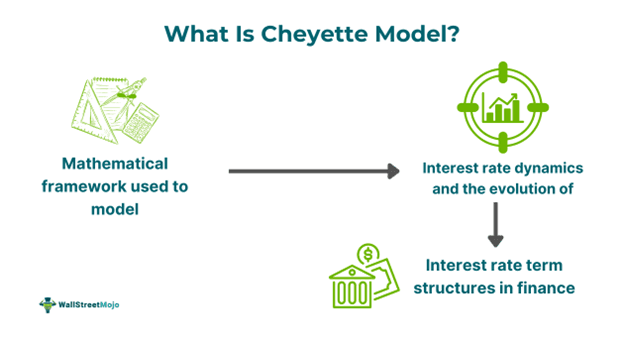Table of Contents
What Is The Cheyette Model?
Cheyette Model, in quantitative finance, is a mathematical model developed by author Oren Cheyette in 1944. The primary purpose of the model is to compute the value of financial securities like interest rate derivatives by incorporating stochastic volatility. It attempts to understand the modeling of interest rates and the structure of interest rate derivatives.

The model extends the Heath-Jarrow-Morton (HJM) framework. It enables a system to provide solutions for the limitations the HJM possesses. It also studies how the volatility smile can affect the pricing of interest rate derivatives. However, various complexities are involved in performing the model.
Key Takeaways
- Cheyette Model is a quantitative finance concept used to determine the prices of interest rate derivatives and modeling purposes.
- It is an extension of the Heath-Jarrow-Morton (HJM) model proposed by Oren Cheyette in 1994. Later, it became famous as the "Cheyette Model."
- The model can be either a one-factor or multi-factor model. Based on it, the market calibration is followed by a set of numbers installed in the model's equation.
- The model's most significant application is within interest rate derivatives, such as swaptions, caps, and floors.
Cheyette Model Explained
The Cheyette Model is an essential concept in mathematical finance for pricing interest rate derivatives. Since the Heath-Jarrow-Morton (HJM) framework involved excess complexity, the Cheyette Model implementation became crucial as an extension of the HJM model. It allows investors and firms to determine the value of financial securities like bonds and interest rate-driven derivatives.
The structure of the model's interest rate has various components, including volatility, which plays a vital role in price formulation. The set of supported volatility functions determines the Cheyette Model's interest rate. The model assumes that the diffusion process affects short-term rates and that volatility follows a stochastic process. This function can be separated based on the time and maturity of the underlying instrument, making it useful for regulatory bodies to set prices for underlying assets.
The model can be either a one-factor or a multi-factor model. Its assumptions depend on the HJM framework, which works similarly but addresses HJM's limitations. There are typically two challenges with the model: implementing it in the financial market and handling complex computational challenges via stochastic processes. The first challenge can be mitigated using the LIBOR rate model, while the second requires a time-dependent structure on the volatility function. Cheyette Model calibration shifts the curve from a high to a low-dimensional framework, and adding a volatility smile or skew can help traders develop pricing strategies.
Equation For Cheyette Model
After understanding the working, let us look at the equation for the model in the financial concept:
One-factor Model
σ(t, T) = Pm(t) − λ(T − t)
Multi-factor Model
σ(t, T) = { σ1(t, T)
σ2(t, T)
σ3(t, T) }
where
σ(t, T) refers to the implied volatility for the financial instruments. Meanwhile, Pm(t) is the market price related to the interest rate derivative. λ is the volatility risk premium. And lastly, (T-t) refers to the time left until the interest rate derivative. The difference between one-factor and multi-factor formulas is that the latter can be used to create a robust, accurate, and realistic framework.
Examples
Let us look at the examples for a better understanding of the concept:
Example #1
Suppose Kevin is a trader who frequently invests in the stock market, focusing on interest rate derivatives like caps, floors, and swaptions. To price these derivatives, Kevin needs to consider various parameters such as mean reversion, volatility, and short-term interest rate structure.
- Market Calibration: The first step involves calibrating the model to market data. This means adjusting the model parameters to match the current market prices of the derivatives as closely as possible.
- Model Calculation: Once calibrated, Kevin generates a set of values for the model equations based on these parameters.
- Valuation: Using the calibrated model, Kevin determines the price of the interest rate derivative.
In this case, Kevin used the model to determine the price of a swaption.
Example #2
In an interview dated June 2023, research analyst Yevgeny Goncharov and Andrei Lyashenko, the head of market pricing models at Quantitative Risk Management, discussed the development of a risk-free framework. They mentioned that the Libor Market Model (LMM) is much lighter and easier to use than the Cheyette model. They also discussed the use of Q-measure quants in the context of the Cheyette models.
Applications
Since the model has many advantages, it has similar applications in the real world. So, let us look at them:
- Fixed Income Securities - Most traders use the model to evaluate fixed-income securities like bonds and other interest-based instruments. As interest rates are taken as a basis, accurate pricing becomes easy. It uses the underlying interest rates as a parameter for pricing financial instruments.
- Interest rate derivatives - Analysts and investors can use the model to price interest rate derivatives. Using stochastic volatility and market parameters, determining the prices of these derivatives is possible.
- Yield Curve - Yield curves can be constructed using the Cheyette model calibration. This helps estimate future interest rates and develop yield curves based on them. The results prove beneficial for creating risk management tactics.

